
(a)
Interpretation:
Condensed formula for 2-methyl-2-hexene has to be drawn.
Concept Introduction:
Organic compounds can be drawn from its IUPAC name. Initially, the parent chain is identified from the IUPAC name. After that the carbon chain is drawn with carbon atoms alone. Next step is to add the substituents in the respective positions as indicated in the IUPAC name. Remaining valency of carbon atom is satisfied by adding correct number of hydrogen atoms.
Condensed structural formula is a simplified form of representation of a molecule. This gives the information about all the atoms present in molecule and the atoms are placed in sequential order which gives information about which atom is bonded to other atom.
(a)
Explanation of Solution
Given IUPAC name is 2-methyl-2-hexene. From this the parent

Numbering of each carbon has to be done as shown,

From the name it is understood that a double bond is present between carbon-2 and carbon-3.

Substituent that is present is a methyl group on carbon-2.

Remaining valency of carbon atom has to be balanced by adding hydrogen atoms.

Condensed formula can be obtained as shown below,
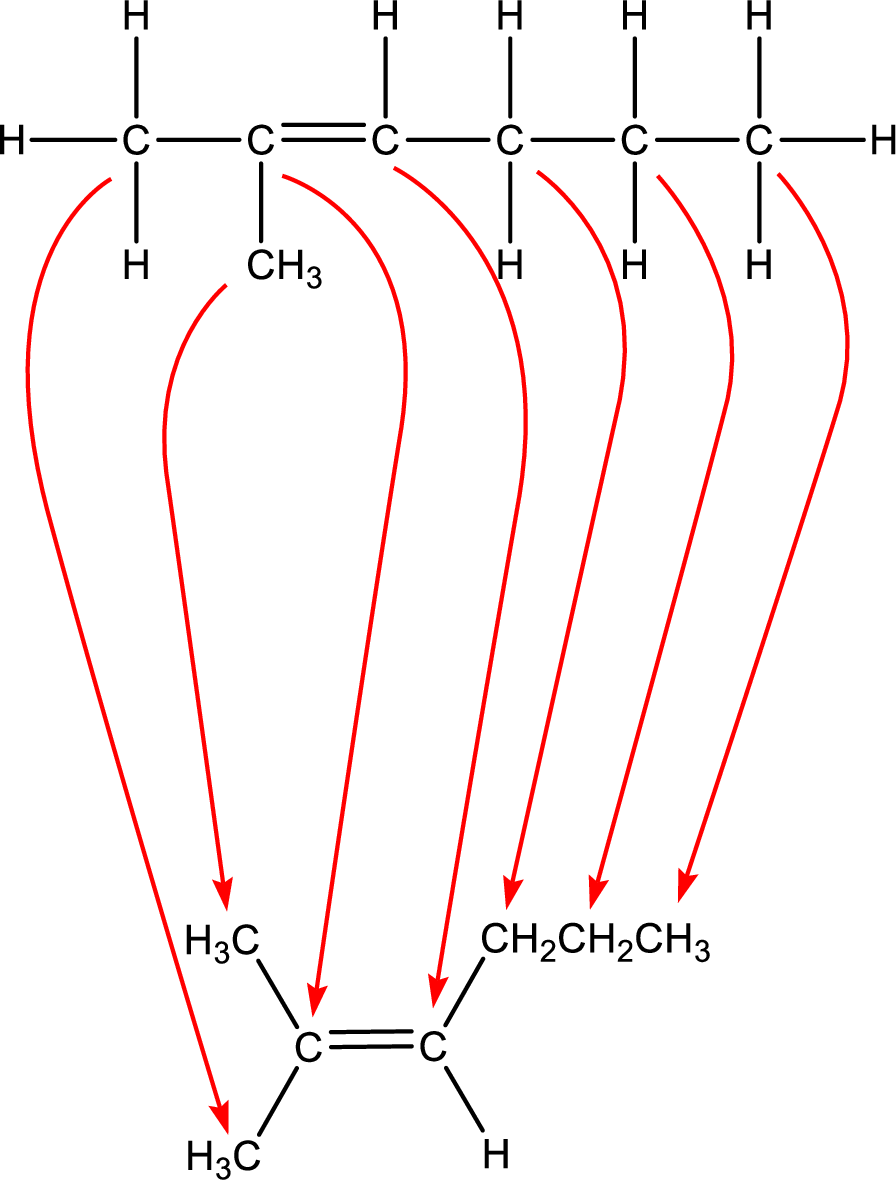
Condensed formula for 2-methyl-2-hexene is drawn as shown.
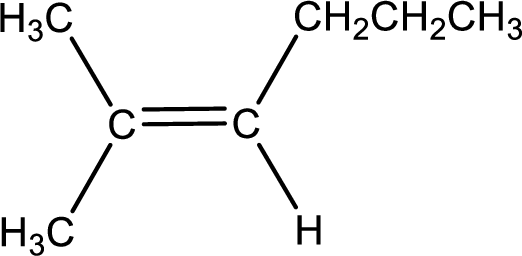
(b)
Interpretation:
Condensed formula for trans-3-heptene has to be drawn.
Concept Introduction:
Refer part (a).
(b)
Explanation of Solution
Given IUPAC name is trans-3-heptene. From this the parent alkane is identified as heptane. Heptane contains seven carbon atoms.

Numbering of each carbon has to be done as shown,

From the name it is understood that a double bond is present between carbon-3 and carbon-4.

As the stereo information is given as trans-, the hydrogen atom that is bonded to the carbon atoms across the double bond has to be in opposite side. Remaining valency of carbon atom has to be balanced by adding hydrogen atoms.

Condensed formula can be obtained as shown below,
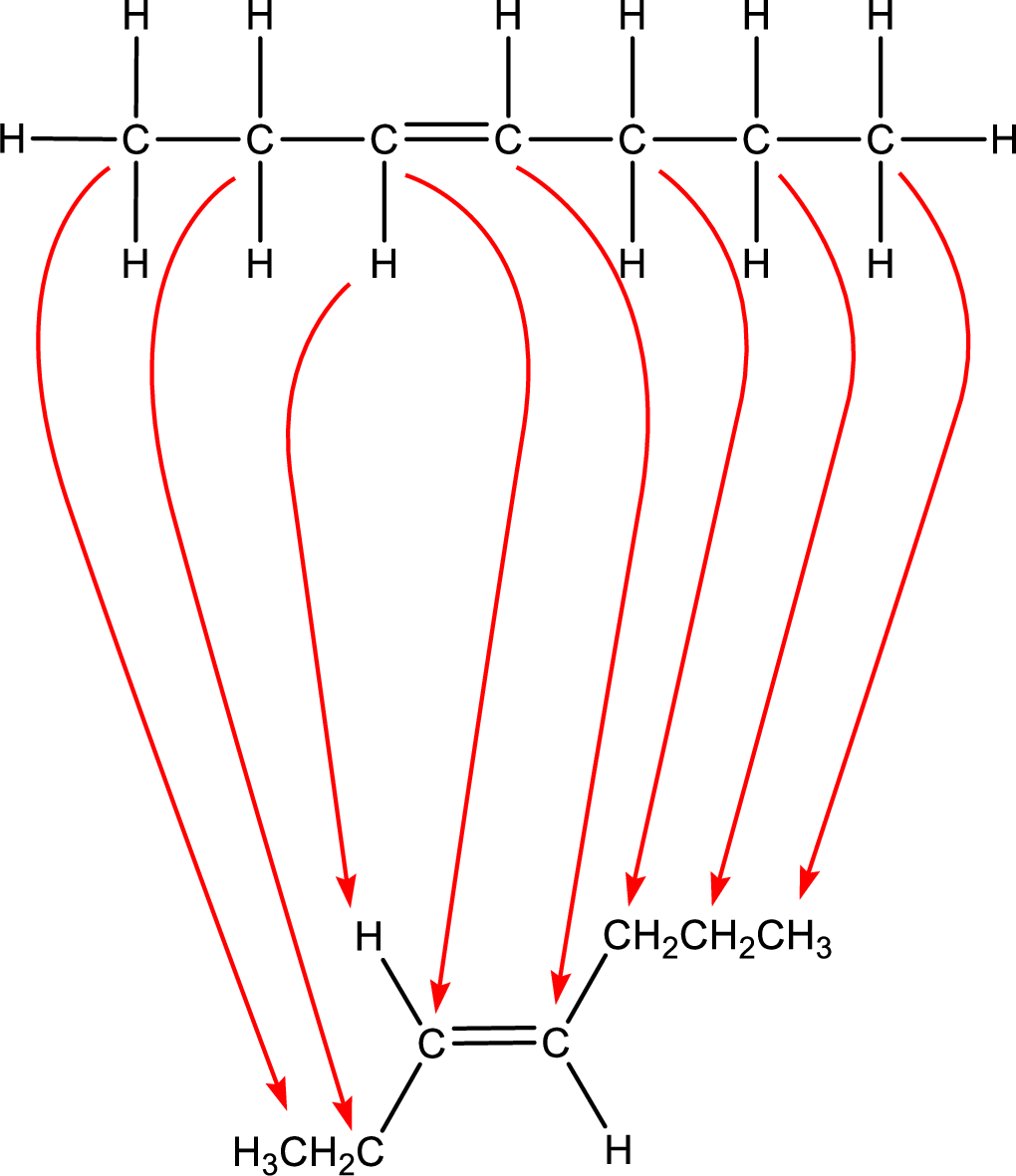
Condensed formula for trans-3-heptene is drawn as shown.
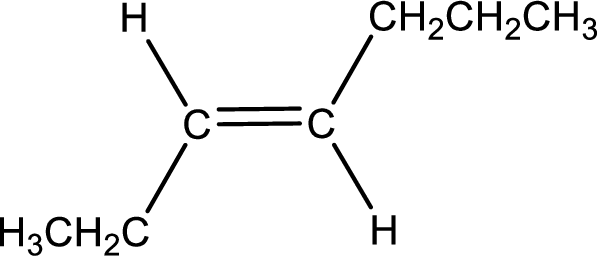
(c)
Interpretation:
Condensed formula for cis-1-chloro-2-pentene has to be drawn.
Concept Introduction:
Refer part (a).
(c)
Explanation of Solution
Given IUPAC name is cis-1-chloro-2-pentene. From this the parent alkane is identified as pentane. Pentane contains five carbon atoms.
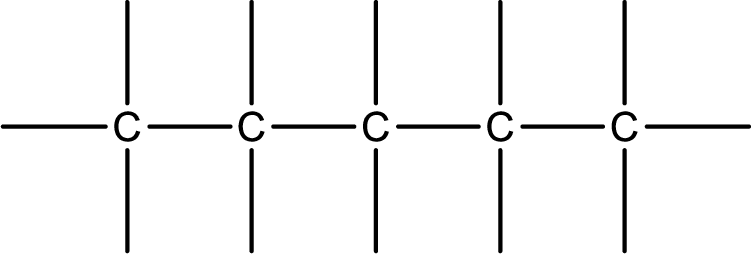
Numbering of each carbon has to be done as shown,
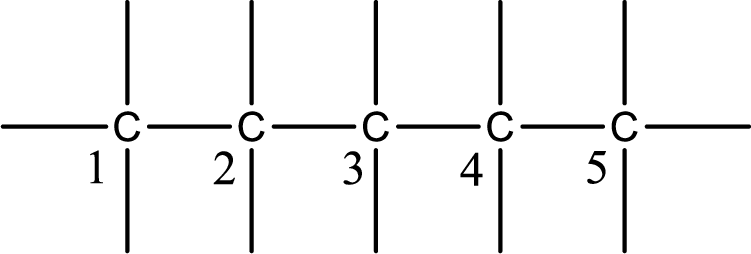
From the name it is understood that a double bond is present between carbon-2 and carbon-3.
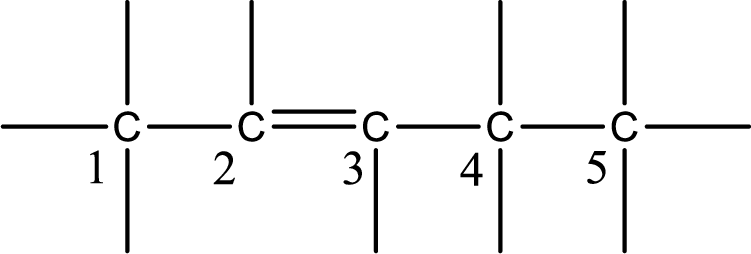
As the stereo information is given as cis-, the hydrogen atom that is bonded to the carbon atoms across the double bond has to be in same side. Subsituents present in the given name is a chlorine atom in on carbon-1. Remaining valency of carbon atom has to be balanced by adding hydrogen atoms.
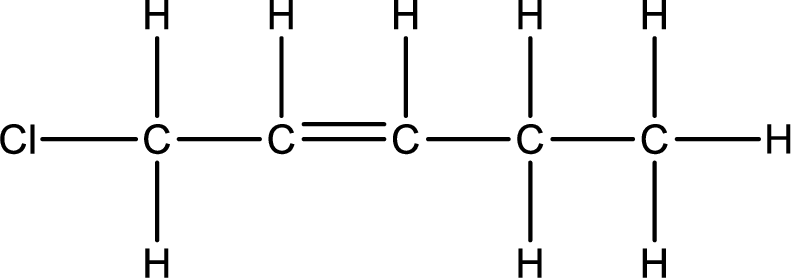
Condensed formula can be obtained as shown below,
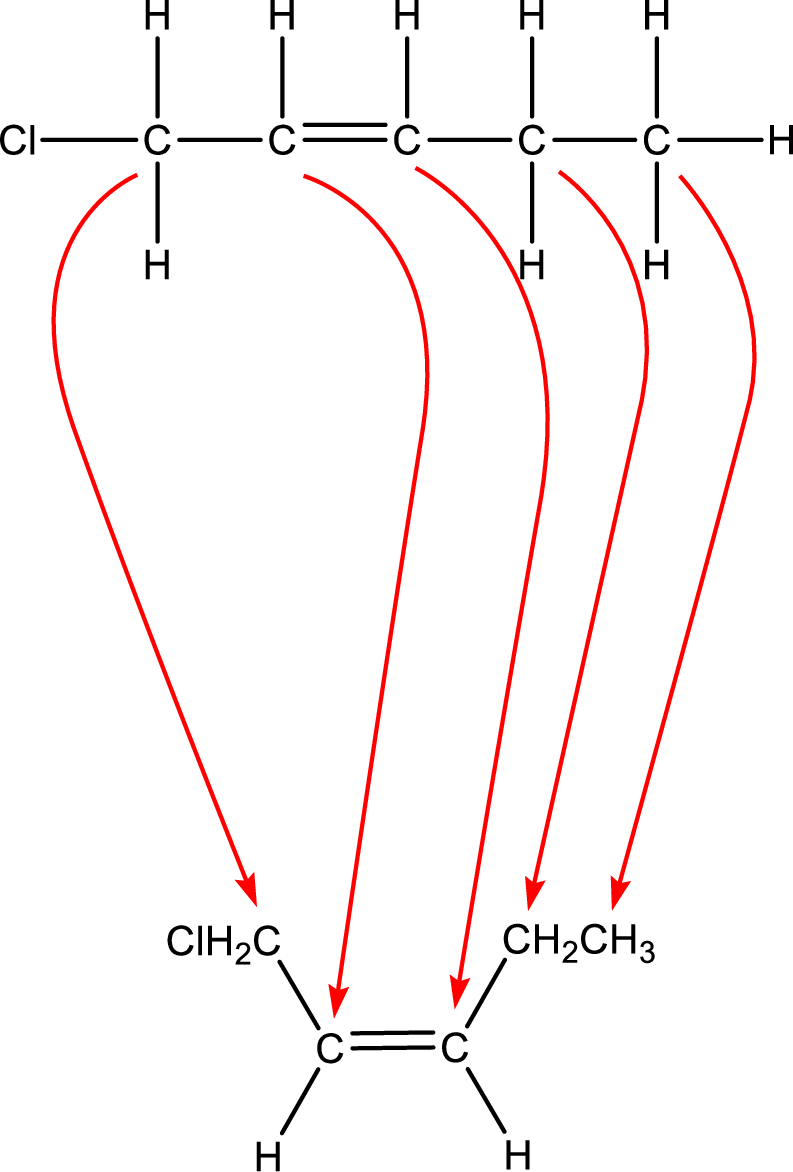
Condensed formula for cis-1-chloro-2-pentene is drawn as shown.
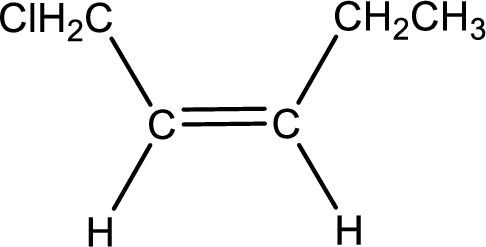
(d)
Interpretation:
Condensed formula for cis-2-chloro-2-methyl-3-heptene has to be drawn.
Concept Introduction:
Refer part (a).
(d)
Explanation of Solution
Given IUPAC name is cis-2-chloro-2-methyl-3-heptene. From this the parent alkane is identified as heptane. Heptane contains seven carbon atoms.

Numbering of each carbon has to be done as shown,

From the name it is understood that a double bond is present between carbon-3 and carbon-4.

As the stereo information is given as cis-, the hydrogen atom that is bonded to the carbon atoms across the double bond has to be in same side. Substituents present in the given name are a chlorine atom in on carbon-2 and methyl group on carbon-2. Remaining valency of carbon atom has to be balanced by adding hydrogen atoms.

Condensed formula can be obtained as shown below,
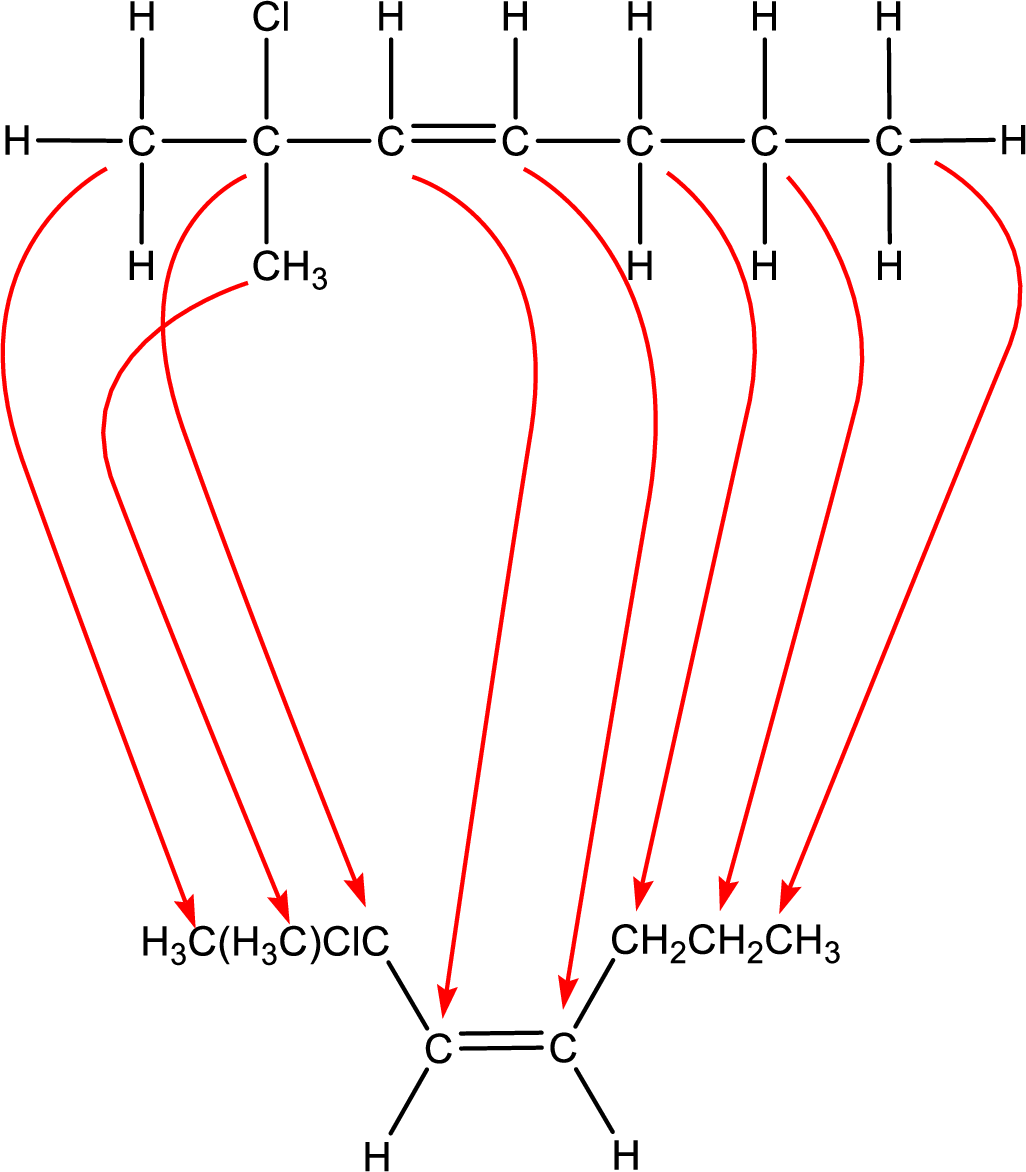
Condensed formula for cis-2-chloro-2-methyl-3-heptene is drawn as shown.
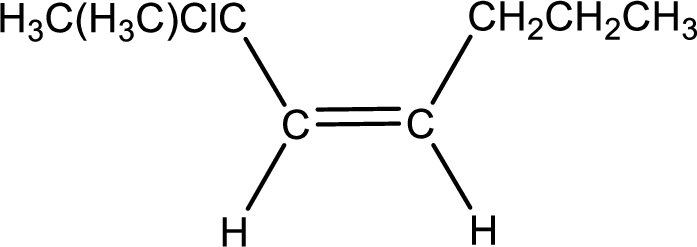
(e)
Interpretation:
Condensed formula for trans-5-bromo-2,6-dimethyl-3-octene has to be drawn.
Concept Introduction:
Refer part (a).
(e)
Explanation of Solution
Given IUPAC name is trans-5-bromo-2,6-dimethyl-3-octene. From this the parent alkane is identified as octane. Octane contains eight carbon atoms.

Numbering of each carbon has to be done as shown,

From the name it is understood that a double bond is present between carbon-3 and carbon-4.

As the stereo information is given as trans-, the hydrogen atom that is bonded to the carbon atoms across the double bond has to be in opposite side. Substituents present in the given name are a bromine atom in on carbon-5, a methyl group on carbon-2, and a methyl group on carbon-6. Remaining valency of carbon atom has to be balanced by adding hydrogen atoms.

Condensed formula can be obtained as shown below,
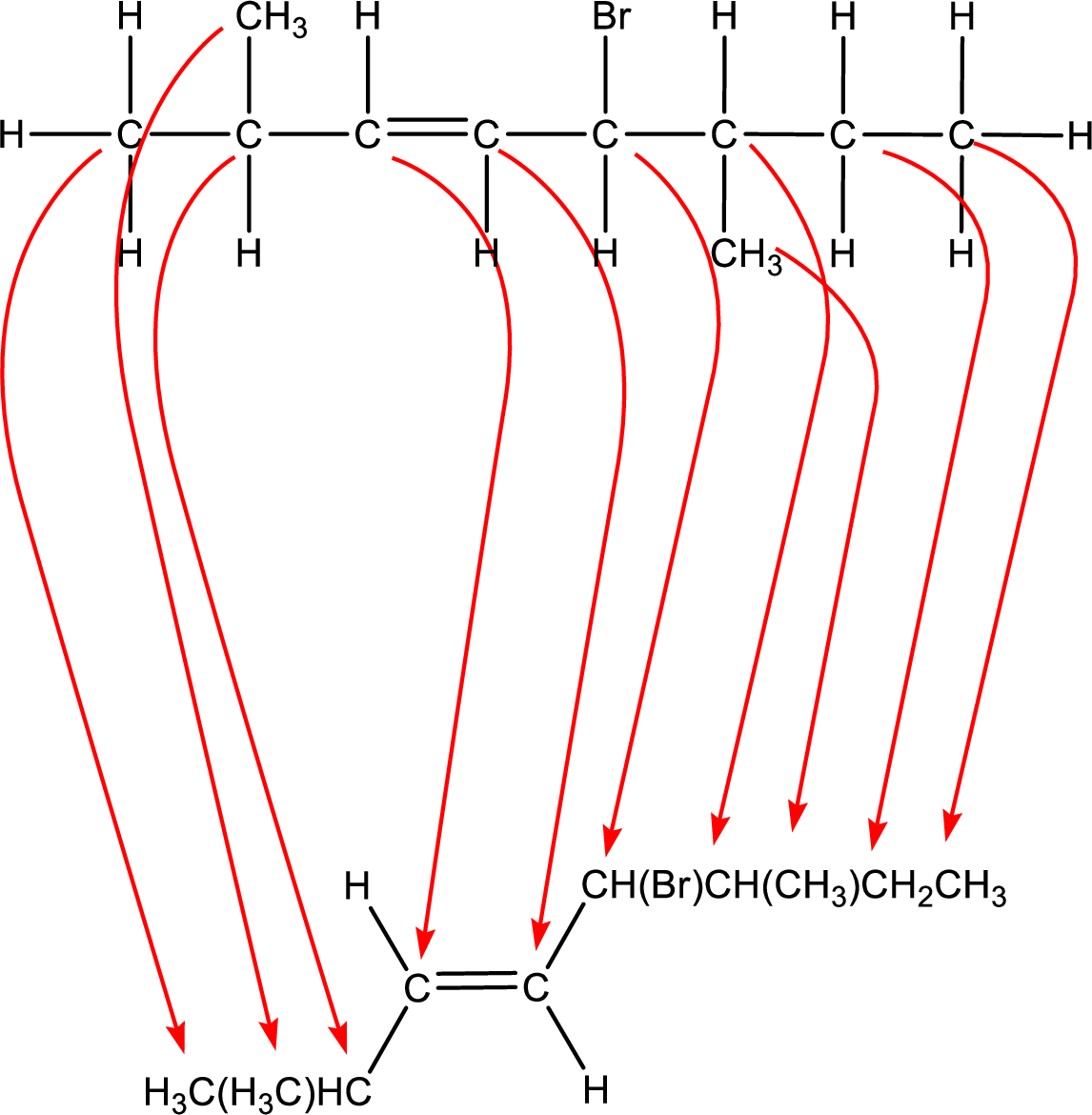
Condensed formula for trans-5-bromo-2,6-dimethyl-3-octene is drawn as shown.

Want to see more full solutions like this?
Chapter 11 Solutions
General, Organic, and Biochemistry
- 18:11 LTE ا... US$50 off hotels is waiting for you Book now, hotels in Nashville are going fast QUTSLIVII 25 61 69 points) | QuestIVIT ALLēm... now Give the IUPAC name for each compound. Part 1 of 3 Part 2 of 3 X ☑ Х Check Save For Later Submit © 2025 McGraw Hill LLC. All Rights Reserved. TOMS CT US ...vacy Center | Accessibilityarrow_forwardDone 19:17 www-awu.aleks.com Chapter 12 HW Question 29 of 39 (6 points) | Question Attempt: 1 of Unlimited .III LTE סוי 27 28 = 29 30 31 32 = 33 34 35 Consider this structure. CH3CH2CH2 Part 1 of 3 3 CH2 CH2CH3 - C-CH2CH 3 H CH₂ Give the IUPAC name of this structure. 3-ethyl-3,4-dimethylheptane Part: 1/3 Part 2 of 3 Draw the skeletal structure. Skip Part < Check Click and drag to start drawing a structure. Save For Later Submit © 2025 McGraw Hill LLC. All Rights Reserved. Terms of Use | Privacy Center | Accessibility Хarrow_forward18:57 .III LTE www-awu.aleks.com Chapter 12 HW Question 31 of 39 (8 points) | Question Attem... Give the IUPAC name of each compound. Part 1 of 4 Part 2 of 4 Х Х Check Save For Later Submit © 2025 McGraw Hill LLC. All Rights Reserved. TOMS OF US vacy Center | Accessibilityarrow_forward
- What is the missing reactant in this organic reaction? CH3-C-CH2-NH2 + R - CH3 O: 0 CH3-N-CH2-C-NH-CH2-C-CH3 + H2O Specifically, in the drawing area below draw the condensed structure of R. If there is more than one reasonable answer, you can draw any one of them. If there is no reasonable answer, check the No answer box under the drawing area. Note for advanced students: you may assume no products other than those shown above are formed. Explanation Check Click anywhere to draw the first atom of your structure. C © 2025 McGraw Hill LLC. All Rights Reserved. Terms of Use | Privacy Center Accesarrow_forwardDone 18:17 • www-awu.aleks.com Chapter 12 HW Question 24 of 39 (4 points) | Question Attempt: 1 of Unlimited ▼ 20 ✓ 21 × 22 23 24 25 26 raw the structure corresponding to each IUPAC name. Part 1 of 2 .III LTE 22 27 28 סוי 29 29 3 A skeletal structure corresponding to the IUPAC name 3-ethyl-4-methylhexane. Part 2 of 2 Click and drag to start drawing a structure. A condensed structure corresponding to the IUPAC name 2,2,4- trimethylpentane. Click anywhere to draw the first atom of your structure. Check Save For Later Submit < Х ப: G © 2025 McGraw Hill LLC. All Rights Reserved. Terms of Use | Privacy Center | Accessibility : Garrow_forwardDone 18:25 www-awu.aleks.com .III LTE Chapter 12 HW Question 29 of 39 (6 points) | Question Attempt: 1 of Unlimi... Oli 23 24 25 26 27 28 29 30 Consider this structure. CH2 CH2CH2 CH2CH2CH₂ C -C. -CH2CH3 H CH Part: 0 / 3 Part 1 of 3 Give the IUPAC name of this structure. Skip Part < Check ☑ Save For Later © 2025 McGraw Hill LLC. All Rights Reserved. Terms of Use | Privacy Center | Accessibility ....................arrow_forward
- Calculate Ecell at 25.0 oC using the following line notation. Zn(s)|Zn+2(aq, 0.900 M)||Cu+2(aq, 0.000200 M)|Cu(s)arrow_forwardPredict the product of this organic reaction: O OH + H + OH A P + H2O Specifically, in the drawing area below draw the skeletal ("line") structure of P. If there isn't any P because this reaction won't happen, check the No reaction box under the drawing area. Explanation Check Click and drag to start drawing a structure. X G ☐ :arrow_forward0.0994 g of oxalic acid dihydrate is titrated with 10.2 mL of potassium permanganate. Calculate the potassium permanganate concentration. Group of answer choices 0.0433 M 0.135 M 0.0309 M 0.193 Marrow_forward
- Experts...can any one help me solve these problems?arrow_forwardAccording to standard reduction potential data in Lecture 4-1, which of the following species is the most difficult to reduce? Group of answer choices Zn2+ AgCl(s) Al3+ Ce4+arrow_forwardWhich Group 1 metal reacts with O2(g) to form a metal peroxide (M2O2)? Group of answer choices Li K Rb Naarrow_forward
 ChemistryChemistryISBN:9781305957404Author:Steven S. Zumdahl, Susan A. Zumdahl, Donald J. DeCostePublisher:Cengage Learning
ChemistryChemistryISBN:9781305957404Author:Steven S. Zumdahl, Susan A. Zumdahl, Donald J. DeCostePublisher:Cengage Learning ChemistryChemistryISBN:9781259911156Author:Raymond Chang Dr., Jason Overby ProfessorPublisher:McGraw-Hill Education
ChemistryChemistryISBN:9781259911156Author:Raymond Chang Dr., Jason Overby ProfessorPublisher:McGraw-Hill Education Principles of Instrumental AnalysisChemistryISBN:9781305577213Author:Douglas A. Skoog, F. James Holler, Stanley R. CrouchPublisher:Cengage Learning
Principles of Instrumental AnalysisChemistryISBN:9781305577213Author:Douglas A. Skoog, F. James Holler, Stanley R. CrouchPublisher:Cengage Learning Organic ChemistryChemistryISBN:9780078021558Author:Janice Gorzynski Smith Dr.Publisher:McGraw-Hill Education
Organic ChemistryChemistryISBN:9780078021558Author:Janice Gorzynski Smith Dr.Publisher:McGraw-Hill Education Chemistry: Principles and ReactionsChemistryISBN:9781305079373Author:William L. Masterton, Cecile N. HurleyPublisher:Cengage Learning
Chemistry: Principles and ReactionsChemistryISBN:9781305079373Author:William L. Masterton, Cecile N. HurleyPublisher:Cengage Learning Elementary Principles of Chemical Processes, Bind...ChemistryISBN:9781118431221Author:Richard M. Felder, Ronald W. Rousseau, Lisa G. BullardPublisher:WILEY
Elementary Principles of Chemical Processes, Bind...ChemistryISBN:9781118431221Author:Richard M. Felder, Ronald W. Rousseau, Lisa G. BullardPublisher:WILEY





